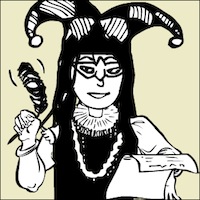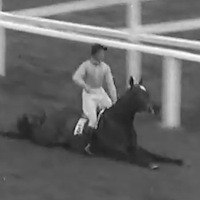Lizzie Borden Acquitted (June 20, 1893)

“Lizzie Borden took an axe
And gave her mother forty whacks.
And when she saw what she had done,
She gave her father forty-one.”
That nursery rhyme typically sums up what many know of Lizzie Borden. She took a hatchet to her mother in the upstairs bedroom of their Fall River, MA home, then went downstairs to her sleeping father and did the same. Most of the blows from the hatchet were to the heads of the victims, resulting in numerous fractures. After killing the two, she called to her servant to come down and help with cleaning up the bodies.
Or did she?
The fact of the matter is a jury of Ms. Borden’s peers acquitted her on the charges, ten months after the murders. So, why today is she still seen as the cruel and harsh murderess of her doting parents? For the same reason OJ Simpson—also found not guilty—is still viewed as the cruel and harsh murderer of Nicole Brown-Simpson and Robert Goldman.
On August 4, 1892, Abby Borden tightened down the sheets on the bed in the guest room. She had no idea that her life was about to come to an abrupt halt. An intruder entered the room and began violently hitting her with a hatchet. Nineteen times the hatchet struck Mrs. Borden, cleaving a 5 inch hole in her skull. Satisfied with the deed being accomplished, the intruder exited the room.
About an hour and a half later, Andrew Borden lay on the couch in the den, resting from the heat. An intruder entered the den and struck him ten times in the head with a hatchet—hard enough to shatter bones, sever an eye in half, and eventually break the hatchet’s handle.
Ten minutes later, Lizzie Borden discovered her father’s body and screamed for the maid. In the spectacular trial that followed—the Trial of the 19th Century—Lizzie’s life turned upside down and inside out. Had Johnny Cochran been Lizzie’s attorney, he may have said something like, “If the axe don’t fit, you must acquit!”
The case built against Lizzie was circumstantial, at best. Her “Dream Team” of lawyers consisted of Andrew Jennings, George Robinson, and Melvin Adams, three of Massachusetts top lawyers. When the prosecution tried to admit Lizzie’s faulty testimony of her whereabouts at the time of the murders, the defense team objected—and the judge agreed—that it was not admissible due to the fact it was given before she was formally charged. “If the axe don’t fit, you must acquit!”
The testimony that Jennings deftly avoided having admitted stated that Lizzie had gone to the barn—or hayloft—for twenty to thirty minutes to look for sinkers. It was during the time she was in the barn that Andrew Borden was brutally murdered. However, when the detectives went to the loft to verify her story, they found a thick, undisturbed layer of dust. The jury would never hear of this rather damning testimony.
Another fact the jury would never hear was the testimony of Dr. Eli Bense, the pharmacist. He would testify that Lizzie Borden attempted to purchase prussic acid from him the day before the murders. The Dream Team argued to the relevance of his testimony and after some thought, the judge agreed and the testimony was deemed inadmissible.
The jury deliberated over the facts presented to them during the ten days of trial. In just under an hour, the twelve jurors came to the unanimous conclusion that Lizzie Andrew Borden was, in fact, innocent of the three charges of murder. Yes, three—the murder of her Stepmother, the murder of her Father, and the murder of both of them.
But, was Lizzie truly innocent? Many, many books have been written on the case and the case has been revisited by Tru-TV, A & E’s Biography, the History Channel and many others. Without having been there at the house at the time of the murders, no one will ever truly know exactly what happened—did Lizzie really laugh from the top of the stairs (where she could clearly see her brutalized stepmother) as Bridget opened the door for Andrew? Was she really emotionless as the police and doctors hustled around her house?
The Lizzie Borden case was the first nationally publicized murder case in the United States. During the OJ Simpson trial, Johnny Cochran bellowed, “If the glove don’t fit, you must acquit!” when the bloody gloves were brought into evidence. After OJ tried them on, they seemed to be too small. Indeed, the jury agreed and found OJ not guilty.
Lizzie Borden had her own “bloody glove.” Her “glove,” however, was actually a dress—a dress she burned in her kitchen stove two days after the murder. She had given the police a silk dress saying that it was what she was wearing that morning while doing her chores. At that time, no well-bred New England girl wore a silk dress in the morning and especially not for doing chores. Perhaps the phrase should have been, “If the dress don’t fit, she used a hatchet!”
For more information on the trial of Lizzie Borden, or to view the sources used for this article, please visit the following links:
Lizzie Borden: Did She Do It?
The Borden House
Lizzie Andrew Borden Virtual Museum and Library
And gave her mother forty whacks.
And when she saw what she had done,
She gave her father forty-one.”
That nursery rhyme typically sums up what many know of Lizzie Borden. She took a hatchet to her mother in the upstairs bedroom of their Fall River, MA home, then went downstairs to her sleeping father and did the same. Most of the blows from the hatchet were to the heads of the victims, resulting in numerous fractures. After killing the two, she called to her servant to come down and help with cleaning up the bodies.
Or did she?
The fact of the matter is a jury of Ms. Borden’s peers acquitted her on the charges, ten months after the murders. So, why today is she still seen as the cruel and harsh murderess of her doting parents? For the same reason OJ Simpson—also found not guilty—is still viewed as the cruel and harsh murderer of Nicole Brown-Simpson and Robert Goldman.
On August 4, 1892, Abby Borden tightened down the sheets on the bed in the guest room. She had no idea that her life was about to come to an abrupt halt. An intruder entered the room and began violently hitting her with a hatchet. Nineteen times the hatchet struck Mrs. Borden, cleaving a 5 inch hole in her skull. Satisfied with the deed being accomplished, the intruder exited the room.
About an hour and a half later, Andrew Borden lay on the couch in the den, resting from the heat. An intruder entered the den and struck him ten times in the head with a hatchet—hard enough to shatter bones, sever an eye in half, and eventually break the hatchet’s handle.
Ten minutes later, Lizzie Borden discovered her father’s body and screamed for the maid. In the spectacular trial that followed—the Trial of the 19th Century—Lizzie’s life turned upside down and inside out. Had Johnny Cochran been Lizzie’s attorney, he may have said something like, “If the axe don’t fit, you must acquit!”
The case built against Lizzie was circumstantial, at best. Her “Dream Team” of lawyers consisted of Andrew Jennings, George Robinson, and Melvin Adams, three of Massachusetts top lawyers. When the prosecution tried to admit Lizzie’s faulty testimony of her whereabouts at the time of the murders, the defense team objected—and the judge agreed—that it was not admissible due to the fact it was given before she was formally charged. “If the axe don’t fit, you must acquit!”
The testimony that Jennings deftly avoided having admitted stated that Lizzie had gone to the barn—or hayloft—for twenty to thirty minutes to look for sinkers. It was during the time she was in the barn that Andrew Borden was brutally murdered. However, when the detectives went to the loft to verify her story, they found a thick, undisturbed layer of dust. The jury would never hear of this rather damning testimony.
Another fact the jury would never hear was the testimony of Dr. Eli Bense, the pharmacist. He would testify that Lizzie Borden attempted to purchase prussic acid from him the day before the murders. The Dream Team argued to the relevance of his testimony and after some thought, the judge agreed and the testimony was deemed inadmissible.
The jury deliberated over the facts presented to them during the ten days of trial. In just under an hour, the twelve jurors came to the unanimous conclusion that Lizzie Andrew Borden was, in fact, innocent of the three charges of murder. Yes, three—the murder of her Stepmother, the murder of her Father, and the murder of both of them.
But, was Lizzie truly innocent? Many, many books have been written on the case and the case has been revisited by Tru-TV, A & E’s Biography, the History Channel and many others. Without having been there at the house at the time of the murders, no one will ever truly know exactly what happened—did Lizzie really laugh from the top of the stairs (where she could clearly see her brutalized stepmother) as Bridget opened the door for Andrew? Was she really emotionless as the police and doctors hustled around her house?
The Lizzie Borden case was the first nationally publicized murder case in the United States. During the OJ Simpson trial, Johnny Cochran bellowed, “If the glove don’t fit, you must acquit!” when the bloody gloves were brought into evidence. After OJ tried them on, they seemed to be too small. Indeed, the jury agreed and found OJ not guilty.
Lizzie Borden had her own “bloody glove.” Her “glove,” however, was actually a dress—a dress she burned in her kitchen stove two days after the murder. She had given the police a silk dress saying that it was what she was wearing that morning while doing her chores. At that time, no well-bred New England girl wore a silk dress in the morning and especially not for doing chores. Perhaps the phrase should have been, “If the dress don’t fit, she used a hatchet!”
For more information on the trial of Lizzie Borden, or to view the sources used for this article, please visit the following links:
Lizzie Borden: Did She Do It?
The Borden House
Lizzie Andrew Borden Virtual Museum and Library
You Should Also Read:
Angel of Death
Salem Witch Trials
Susan Atkins

Related Articles
Editor's Picks Articles
Top Ten Articles
Previous Features
Site Map
Content copyright © 2023 by Christa Mackey. All rights reserved.
This content was written by Christa Mackey. If you wish to use this content in any manner, you need written permission. Contact Lane Graciano for details.







